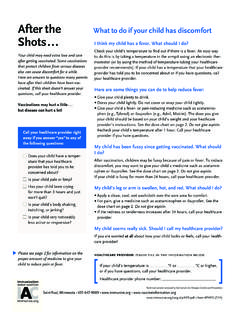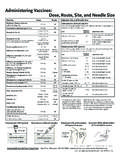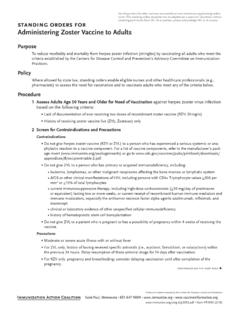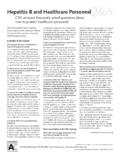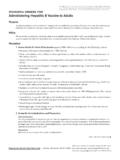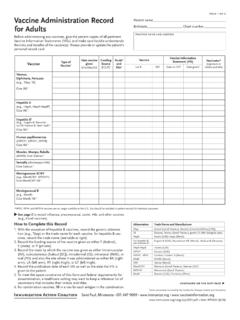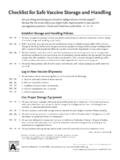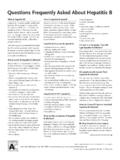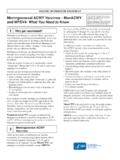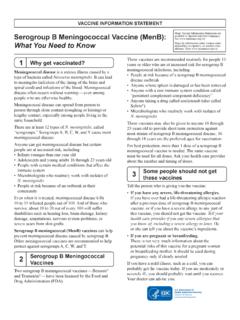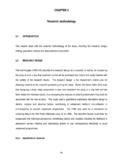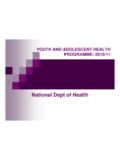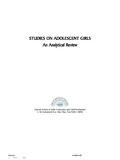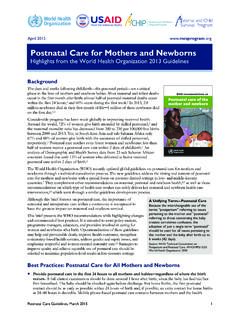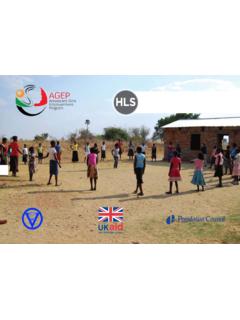Transcription of Summary of Recommendations for Child/Teen Immunization
1 Vaccine name and routeSchedule for routine vaccination and other guidelines (any vaccine can be given with another, unless otherwise noted)Schedule for catch-up vaccination and related issuesContraindications and precautions (mild illness is not a contraindication)Hepatitis B(HepB)Give IM Give HepB dose #1 within 24hrs of birth to all medically stable infants weighing >2000g and born to HBsAg-negative mothers. Give dose #2 at age 1 2m and the final dose at age 6 18m (the last dose in the infant series should not be given earlier than age 24wks). After the birth dose, the series may be completed using 2 doses of single-antigen vaccine (ages 1 2m, 6 18m) or with 3 doses of Pediarix (ages 2m, 4m, 6m), which may result in giving a total of 4 doses of HepB vaccine. If mother is HBsAg-positive: Give HBIG and HepB dose #1 within 12hrs of birth; complete series by age 6m.
2 If mother s HBsAg status is unknown: Give HepB dose #1 within 12 hrs of birth. If low birth weight (less than 2000g), also give HBIG within 12hrs. For infants weighing 2000g or more whose mother is subsequently found to be HBsAg positive, give the infant HBIG ASAP (no later than age 7d) and follow HepB Immunization schedule for infants born to HBsAg-positive mothers. Vaccinate all other children and teens who have not completed a series of HepB vaccine. Do not restart series, no matter how long since previous dose. 3-dose series can be started at any age. Minimum intervals between doses: 4wks between #1 and #2, 8wks between #2 and #3, and at least 16wks between #1 and #3 (and give dose #3 no earlier than age 24wks).Contraindication Previous severe allergic reaction ( , anaphylaxis) to this vaccine or to any of its components, including hypersensitivity to Moderate or severe acute illness, with or without fever.
3 For infants who weigh less than 2000g, see ACIP recommenda-tions at P, DT(Diphtheria, tetanus, acellular pertussis)Give IM Give to children at ages 2m, 4m, 6m, 15 18m, and 4 6yrs. May give dose #1 as early as age 6wks. May give #4 as early as age 12m if 6m have elapsed since #3. Do not give DTaP/DT to children age 7yrs and older. If possible, use the same DTaP product for all doses. Dose #2 and #3 may be given 4wks after previous dose. Dose#4 may be given 6m after #3. If dose #4 is given before 4th birthday, wait at least 6m for #5 (age 4 6yrs). If dose #4 is given after 4th birthday, #5 is not Previous severe allergic reaction ( , anaphylaxis) to this vaccine or to any of its components, with or without fever. For all pertussis-containing vaccines: Encephalopathy not attrib-utable to an identifiable cause, within 7d after DTP/ Moderate or severe acute illness.
4 History of Arthus reaction following a prior dose of tetanus or diphtheria toxoid-containing vaccine (including MenACWY); defer vaccination until at least 10yrs have elapsed since the last tetanus toxoid-containing vaccine. Guillain-Barr syndrome (GBS) within 6wks after previous dose of tetanus toxoid-containing vaccine. For DTaP only: Any of these events following a previous dose of DTP/DTaP: 1) temperature of 105 F ( C) or higher within 48hrs; 2) continuous crying for 3hrs or more within 48hrs; 3) collapse or shock-like state within 48hrs; 4) seizure within 3d. For all pertussis-containing vaccines: Progressive or unstable neurologic disorder, uncontrolled seizures, or progressive encephalopathy until a treatment regimen has been established and the condition has , Tdap(Tetanus, diphtheria, acellular pertussis)Give IM For children and teens lacking previous Tdap: Give Tdap routinely at age 11 12yrs and vaccinate older teens on a catch-up basis; then boost every 10yrs with Td.
5 Make special efforts to give Tdap to children and teens who are 1) in contact with infants younger than age 12m and, 2) healthcare workers with direct patient contact. Give Tdap to pregnant adolescents during each pregnancy (preferred during the early part of gestational weeks 27 through 36wks), regardless of interval since prior Td or Tdap. DTaP and DT should not be used for children age 7yrs and older; use Td and Tdap instead. Children as young as age 7yrs and teens who are unvaccinated or behind schedule should complete a primary Td series (3 doses, with an interval of 1 2m between dose #1 and #2, and an interval of 6 12m between dose #2 and #3); substitute Tdap for any dose in the series, preferably as dose #1. Tdap should be given regardless of interval since previous document was adapted from the Recommendations of the Advisory Committee on Immunization Practices (ACIP).
6 To obtain copies of these Recommendations , visit CDC s website at or visit the Immunization Action Coalition (IAC) website at This table is revised periodically. Visit IAC s website at to make sure you have the most current the purposes of calculating intervals between doses, 4 weeks = 28 days. Intervals of 4 months or greater are determined by calendar vaccine series does not need to be restarted, regardless of the time that has elapsed between doses. Special Notes on Hepatitis B Vaccine (HepB)Dosing of HepB: Monovalent vaccine brands are interchangeable. For people age 0 through 19yrs, give mL of either Engerix-B or Recombivax dosing schedule for unvaccinated adolescents age 11 through 15yrs: Give 2 doses Recombivax HB mL (adult formulation) spaced 4 6m apart.
7 (Engerix-B is not licensed for a 2-dose schedule.) Summary of Recommendations for Child/Teen Immunization (Age birth through 18 years) PAGE 1 OF 6 Immunization Action Coalition Saint Paul, Minnesota 651-6 47-9009 content reviewed by the Centers for Disease Control and Item #P2010 (5/18) Immunization Action Coalition (5/18) Summary of Recommendations for Child/Teen Immunization (Age birth through 18 years) PAGE 2 OF 6 Vaccine name and routeSchedule for routine vaccination and other guidelines (any vaccine can be given with another, unless otherwise noted)Schedule for catch-up vaccination and related issuesContraindications and precautions (mild illness is not a contraindication)Rotavirus (RV)Give orally Rotarix (RV1): Give at ages 2m, 4m. RotaTeq (RV5): Give at ages 2m, 4m, 6m.
8 May give dose #1 as early as age 6wks. Give final dose no later than age 8m 0d. Do not begin series in infants older than age 14wks 6d. Intervals between doses may be as short as 4wks. If prior vaccination included use of different or unknown brand(s), a total of 3 doses should be Previous severe allergic reaction ( , anaphylaxis) to this vaccine or to any of its components. If allergy to latex, use RV5. History of intussusception. Diagnosis of severe combined immuno-deficiency (SCID).Precautions Moderate or severe acute illness, with or without fever. Altered immunocompetence other than SCID. Chronic gastrointestinal disease. For RV1 only, spina bifida or bladder (Haemophilus influenzae type b)Give IM ActHib (PRP-T), Hiberix, or Pentacel: Give at age 2m, 4m, 6m, 12 15m (booster dose).
9 PedvaxHIB (containing PRP-OMP): Give at age 2m, 4m, 12 15m (booster dose). Dose #1 of Hib vaccine should not be given earlier than age 6wks. Give final dose (booster dose) no earlier than age 12m and a minimum of 8wks after the previous dose. Hib vaccines are interchangeable; however, if different brands of Hib vaccines are administered for dose #1 and dose #2, a total of 3 doses is necessary to complete the primary series in infants, followed by a booster after age 12m. For vaccination of children 12 through 59m who are immunocompro-mised (immunoglobulin deficiency, complement component deficiency, HIV infection, receipt of chemotherapy or radiation therapy for cancer) or asplenic: if previously received no doses or only 1 dose before age 12m, give 2 additional doses at least 8wks apart; if previously received 2 or more doses before age 12m, give 1 additional dose.
10 Hib is not routinely given to healthy children age 5yrs and older. 1 dose of Hib vaccine should be administered to children age 5yrs and older who have anatomic or functional asplenia (including sickle cell disease) and who have not received a primary series and booster dose or at least 1 dose of Hib vaccine after age 14m. 1 dose of Hib vaccine should be administered to unvaccinated persons 5 through 18yrs of age with HIV Hib vaccines: If dose #1 was given at 12 14m, give booster in 8wks. Give only 1 dose to unvaccinated children ages 15 : Dose #2 and #3 may be given 4wks after previous dose. If dose #1 was given at age 7 11m, only 3 doses are needed; #2 is given at least 4wks after #1, then final dose at age 12 15m (wait at least 8wks after dose #2).PedvaxHIB: Dose #2 may be given 4wks after # of hematopoietic stem cell transplant should receive 3 doses of Hib vaccine at least 4wks apart beginning 6 12m after transplant, regardless of Hib vaccination Previous severe allergic reaction ( , anaphylaxis) to this vaccine or to any of its components.
